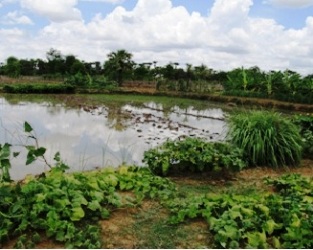If you came to visit Kim Seng’s farm in Kompong Speu province twenty years ago, you would have found six hectares of rice paddy that produced about five tons of rice each year. This was not enough to feed himself and his family of 12. Since that time, Kim Seng has followed the traditional Cambodian practice and given some land to each of his seven married children.
If you came to visit Kim Seng’s farm in Kompong Speu province twenty years ago, you would have found six hectares of rice paddy that produced about five tons of rice each year. This was not enough to feed himself and his family of 12. Since that time, Kim Seng has followed the traditional Cambodian practice and given some land to each of his seven married children.
This has left him with only two and a half of his original six hectares of land. Despite this loss, he still harvests five tons of rice each year!
The secret to his success is training. Kim Seng lives in Trapaing Leap Village, one of the working areas of CRWRC’s partner Communities For Transformation (CFT). A few years ago he participated in CFT’s training on the System of Rice Intensification (SRI). He decided to try this new style of rice growing for himself. He was excited to find that using SRI he could get the same amount of rice on less than half of the acreage! He didn’t have to use as much seed either, so he could make a greater profit.
He then decided to participate in other trainings offered by CFT. He learned about organic fruit and vegetable production in 2009 and also got to participate in an exposure visit to see for himself what other farmers were doing. He was inspired by what he saw and realized that he too could use these methods and could be an example for his neighbors. He is now growing beans, pumpkins, bananas, papaya, melons, lemon grass, and sugar cane. He is also using some of the methods of soil improvement that he learned in CFT’s training and his farm is a green oasis in the middle of a brown landscape.
In 2010, he participated in training on fish-raising. He realized that this would be a beneficial addition to his farm. He recently started raising catfish, tilapia and carp as well as local varieties of fish. He has not yet sold any fish, but the prospects look good and he has plans to expand his fish-raising operations. He also keeps 10 chickens. These two sources of protein will help to supplement his family’s diet and extras can be sold to supplement their income.
Kim Seng’s family now has plenty to eat from what he grows. They also make about $2.50 a day from the sale of their produce. This is enough to cover their needs and allows them to contribute to weddings, funerals, and local ceremonies in the traditional manner without going into debt like many of their neighbors.
Kim Seng has eagerly adopted everything that he has learned. He is considered a model farmer and he inspires others to see the possibilities for their own land.

